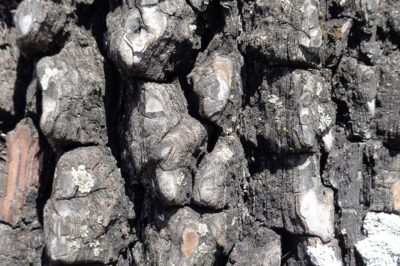Bark Color
While they’re native to different continents, American and Oriental persimmons (Diospyros virginiana, Diospyros kaki) share the same bark characteristics. Young bark is pale gray or reddish brown. As it ages, the trunk bark develops fissures revealing the orange-brown inner bark. On mature trees, the trunk bark is charcoal or black, streaked with dark gray.
Bark Texture
Picture a tree trunk covered in charcoal briquettes. That’s what persimmon bark scales resemble. They’re square to rectangular, flat topped and separated by deep furrows. Only the trunks have such distinctive bark; the branches remain smooth.
Bark Ornamental Value
The bark’s black color and obvious block pattern make identifying wild persimmon trees a snap. In home landscapes, they’re striking ornamental features when paired with the trees’ ripe yellow, orange or red fruit or a backdrop of snow.
How Persimmon Tree Bark Is Made
A persimmon tree’s bark comes from a its cambium. That’s the fragile layer of tissue where the xylem (sapwood) and phloem (inner bark) are made. The inner bark moves sap throughout the trees. When its sap-transporting cells are exhausted, the tree pushes them to the surface to become protective outer bark.
The Inner Bark’s Medicinal Uses
Besides being the building blocks for the outer bark, American persimmon trees’ inner bark has a long history of medicinal use:
- The Native American Catawbas of the Carolina Piedmont region made a mouthwash by boiling persimmons’ inner bark. They used it to treat fungal infections.
- Colonial doctors treated patients suffering from dysentery with a concoction of the powdered inner bark, rhubarb and wine.
- By the late 19th century, doctors were relying on the inner bark’s antiseptic properties to treat skin ulcers, diphtheria and venereal disease.
How Persimmon Bark Helps the Trees
Think of the bark as a suit of wool-lined armor, protecting the trees against:
- Cold. American and Oriental persimmon trees grow USDA plant hardiness zones 4 though 9 and 7 through 10, respectively. Their bark shuts out winter lows ranging from -30° to 25°F (-34.4° to -1.1°C).
- Drying winds.
- Fungal diseases and wood-devouring pests.
Expert gardener’s tip When caring for persimmon trees, take care not to damage their bark. The wounds invite an infestation of phloem-devouring flathead borers.
